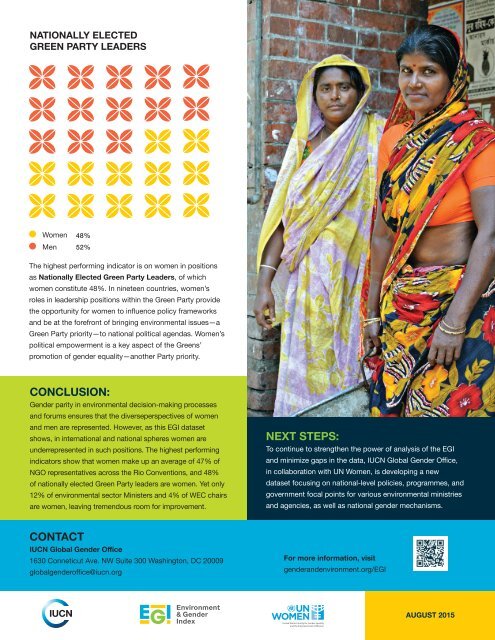Women’s Participation in Global Environmental Decision Making
STl2C
STl2C
You also want an ePaper? Increase the reach of your titles
YUMPU automatically turns print PDFs into web optimized ePapers that Google loves.
NATIONALLY ELECTED<br />
GREEN PARTY LEADERS<br />
Women<br />
Men<br />
48%<br />
52%<br />
The highest perform<strong>in</strong>g <strong>in</strong>dicator is on women <strong>in</strong> positions<br />
as Nationally Elected Green Party Leaders, of which<br />
women constitute 48%. In n<strong>in</strong>eteen countries, women’s<br />
roles <strong>in</strong> leadership positions with<strong>in</strong> the Green Party provide<br />
the opportunity for women to <strong>in</strong>fluence policy frameworks<br />
and be at the forefront of br<strong>in</strong>g<strong>in</strong>g environmental issues—a<br />
Green Party priority—to national political agendas. <strong>Women’s</strong><br />
political empowerment is a key aspect of the Greens’<br />
promotion of gender equality—another Party priority.<br />
CONCLUSION:<br />
Gender parity <strong>in</strong> environmental decision-mak<strong>in</strong>g processes<br />
and forums ensures that the diverseperspectives of women<br />
and men are represented. However, as this EGI dataset<br />
shows, <strong>in</strong> <strong>in</strong>ternational and national spheres women are<br />
underrepresented <strong>in</strong> such positions. The highest perform<strong>in</strong>g<br />
<strong>in</strong>dicators show that women make up an average of 47% of<br />
NGO representatives across the Rio Conventions, and 48%<br />
of nationally elected Green Party leaders are women. Yet only<br />
12% of environmental sector M<strong>in</strong>isters and 4% of WEC chairs<br />
are women, leav<strong>in</strong>g tremendous room for improvement.<br />
NEXT STEPS:<br />
To cont<strong>in</strong>ue to strengthen the power of analysis of the EGI<br />
and m<strong>in</strong>imize gaps <strong>in</strong> the data, IUCN <strong>Global</strong> Gender Office,<br />
<strong>in</strong> collaboration with UN Women, is develop<strong>in</strong>g a new<br />
dataset focus<strong>in</strong>g on national-level policies, programmes, and<br />
government focal po<strong>in</strong>ts for various environmental m<strong>in</strong>istries<br />
and agencies, as well as national gender mechanisms.<br />
CONTACT<br />
IUCN <strong>Global</strong> Gender Office<br />
1630 Conneticut Ave. NW Suite 300 Wash<strong>in</strong>gton, DC 20009<br />
globalgenderoffice@iucn.org<br />
For more <strong>in</strong>formation, visit<br />
genderandenvironment.org/EGI<br />
AUGUST 2015


